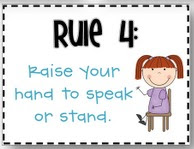When rules are explained a time or two and then left hanging on the wall, they are only decorations, not really part of the class. Students are not going to remember rules in the way that the teacher wants them to unless they are more intimately connected to them.
We will practice saying the rules while using both hands for the coordinating motions.
Rule #1: Listen (point to your ears) when your teacher (kids point to me) is talking (move hands together and apart like a mouth).
Rule #4: Raise your hand (raise your right hand) to speak (make moving mouth motion) or stand (use index and middle finger to 'walk').
These rules are based on the research behind Whole Brain Teaching's five classroom rules which can be found here. Studies show that the more sensory systems we engage in learning, the greater the chance of remembering. We also know that we learn best when we teach someone else. The gestures provide visuals for those watching and the kinesthetic aspect is beneficial for those reciting the rules. Students will practice the rules as a class and teach them to each other in pairs.
In addition to ideas for the rules themselves, I have also adopted Whole Brain Teaching's method of reinforcing our rules. If students are talking while I am, I will hold up one finger and call out "rule one" instead of the students' names. Everyone will hold up one finger while saying the "rule number one" and then announce the rule while doing its gestures. This serves as a reminder for the entire class and avoids creating a negative atmosphere.
This method gets class rules off the walls and into the heads of students.
























